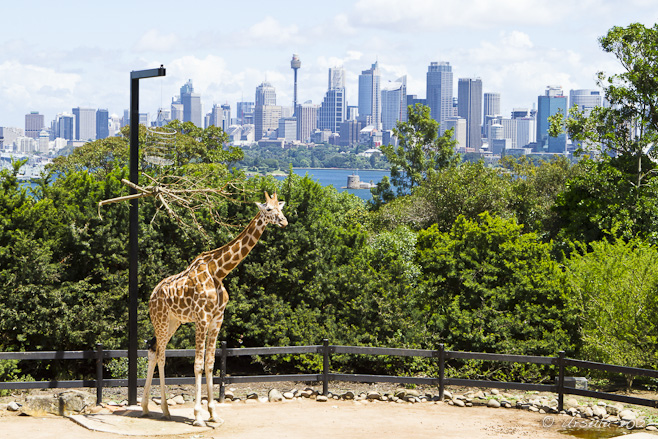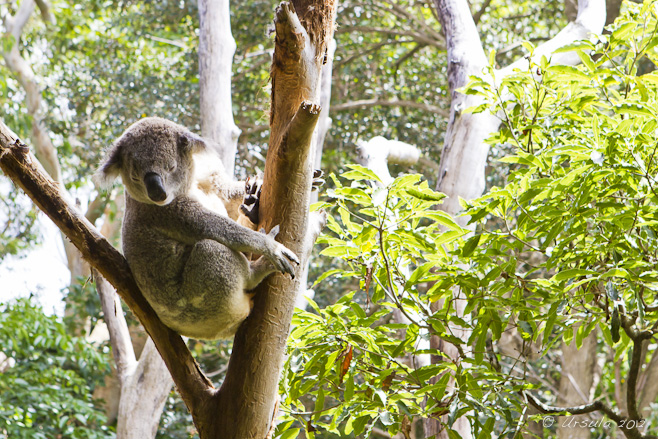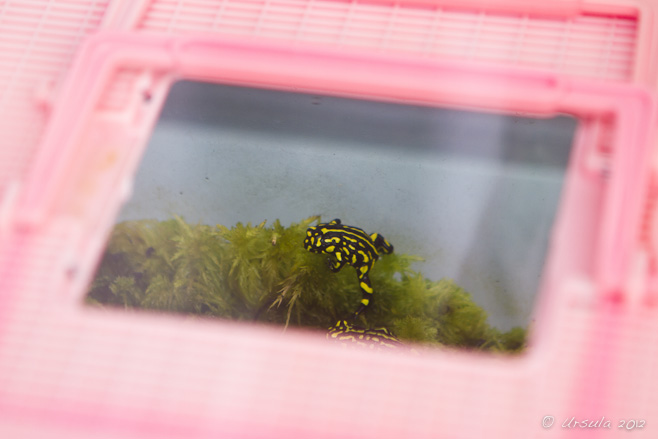
Location, Location, Location!
The giraffes at Taronga Zoo have a commanding view overlooking Fort Dennison and central Sydney.
As politically-incorrect as it might be, I love visiting zoos. There is something magical about being able to get up close-and-personal to some of the world’s wild creatures.
Ok – so they are not entirely wild creatures when they are held, and often born and bred, in captivity. I understand the arguments for and against zoos, arguments which have changed over time, and have led to changes in zoo design:
- Zoos as Jails (mid 19th to late 19th century)
- Zoos as Art Galleries OR the Modernist Movement (early to mid 20th century)
- Zoos as Conservation and Education Facilities
Modern zoos, with their focus on ethics and animal rights, are designed as much (perhaps more) for the comfort of their creatures than for the convenience of their visitors. And although, philosophically, I agree with this, I can’t help but think there is something ironic about being able to get better animal pictures in the wild!
These were some of my thoughts as I dragged the cameras across Sydney Harbour and around Taronga Zoo in Mosman in February, and along the roadways and pathways on the three kilometre stroll around the Taronga Western Plains Zoo outside Dubbo, in central New South Wales, earlier this month. On both visits, many of the animals took refuge away from prying eyes and lenses.
Don’t get me wrong: I loved the zoos themselves. Both the Tarongas are in killer locations.
Opened in 1916, the original Taronga Zoo is located on the shores of Sydney Harbour in the suburb of Mosman. The views across the harbour and over downtown Sydney are stunning. While we were there, a woman told me that the view from one particular spot was Heritage Listed, although I could later find no evidence – outside the view itself – for her claim.

In the Mosman koala house, we found one sleepy marsupial. They were all hiding when we went through the Western Plains Zoo.

The tiny corroboree frog is one of Australia’s most critically endangered frogs.

Small lizard on a log in the reptile house.

Chimpanzees in a huddle, Taronga Zoo.

Most of the chamois were hiding among the rocks, but this one stood out against the sky.

The silverback and his family pointedly ignore the audience.

After a patient wait, the best I could get was the male’s profile, as he delicately extracted the kernels from a pine cone.

A gibbon peaks out from the foliage.

A cheeky rainbow lorikeet with a bad foot mooched food from us as we ate lunch.

Zoo-Keeper Joseph explains the habits of the blue-tongue skink to a small audience…

… and hands the skink carefully around.

Ironically, we get a better look at pelicans at home, as we watch them on the lake, than we did at the Mosman zoo, where the only one we saw was hiding in sleep.
Although it makes efficient use of its space and houses a lot of animals, the 52 acre Mosman site has no room for growth. The Western Plains Zoo was conceived in the 1960s as a facility to allow for the breeding of larger plains animals and to give grazing animals the room they need to roam. An old WWII army training camp in central NSW, about five and a half hours north-west of Sydney by car, was converted into 300 hectares (about 3 sq km) of irrigated grasslands and opened to the public as Australia’s first open-range zoo in 1977.

Welcome to Taronga Western Plains Zoo where they are currently celebrating Kenya and the animals of the savanna.

A we guarded our lunch, an Australian white ibis raided a chip from the empty table next to us.

On their own island, protected by water and distance, ring-tailed lemur can ignore the visitors.

I had as much fun watching the local birds – this one a cheeky apostlebird – as I did trying to find the elusive animals.

Although they don’t have the harbour views that their counterparts at Mosman enjoy, the giraffes at Western Plains have been busy. Little Fanana, meaning ‘to resemble’ in Swahili, was born in August.

The animals are often elusive, but the times for feedings and and zookeeper-talks are posted. So, if you have the time, you can plan your days accordingly.

Zookeeper Melanie explains the habits of the hippopotamus.

After years of living in Thailand, Asian elephants have become almost common-place to us. It was nice to see the African elephant – even if she looked pretty bored, stirring up dirt in the bare paddock.

The magnificent Sumatran tiger didn’t even flick his tail. We commented to each other that we’d been closer to tigers at the Ranthambore Tiger Reserve in Rajasthan.

White Handed Gibbon

It is spring: delicate white blossoms adorn a eucalyptus tree.

A babbler searched for slugs and bugs.

A siamang, largest of the gibbons and lesser apes, takes a flying leap –

– while mother and child come in for a landing.

The young zebra born 24 August, is named Neo, meaning gift in Setswana (Botswana).

Purple wildflowers add colour to the grasslands.

Swamp Wallaby
The little swamp wallaby, drinking cautiously from the pool, reminded me what a privilege it is to get so close to a wild creature.
For while it is true that we have seen many animals better in the wild, in their natural environments, there are many others that we haven’t. Even local animals, like the swamp wallaby, we are more likely to see dead at the side of a road, than drinking from a pool. And, habitats are shrinking the world over.
 The 2012 Master Plan for Taronga Zoo and Taronga Western Plains Zoo includes the stated belief in a shared future for Wildlife and People.
The 2012 Master Plan for Taronga Zoo and Taronga Western Plains Zoo includes the stated belief in a shared future for Wildlife and People.
Let’s hope it succeeds!
Photos: 21February2012 and 08October2012

































.png)
.png)


Fabulous Ursula, its been a few years since I’ve been at either but I love them both. I get that you are torn, me too. But some of these precious creatures aren’t going to survive man, so we need to have safe havens for them, and sometimes a zoo is the only place that can make an income to support them. Hard but necessary I think.
Exactly, Signe!
And, with regards to income – both zoos charge like a wounded rhino. Ouch!